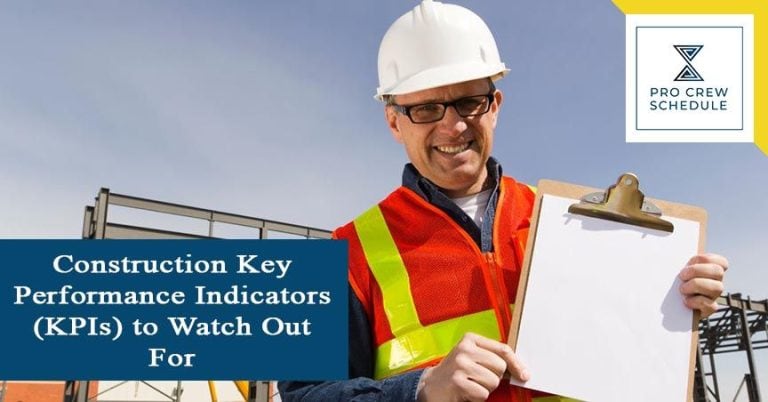As a general contractor or a project manager, your commitment to your clients is always to deliver your projects on schedule and within budget, all without compromising success. So, how do you measure if your construction project is a success? Most companies treat financials as the leading performance indicator of the project’s progress. However, a few other important KPIs for construction can show if a project is on track and give more actionable information about what needs to be changed.
The only way to measure your project’s performance should not be money-based. So why do projects always pay the most attention to them? Other necessary measurements must be considered to track construction progress and productivity, which are the most important things for teams that want to be successful. This article discusses key performance indicators (KPIs), their importance, and metrics that your construction company should measure to improve profits and productivity.
Construction Key Performance Indications (KPIs) in A Nutshell
First off, let us define what a construction KPI is. KPI stands for “key performance indicators.” It is a way to figure out how well something is doing. From a construction point of view, KPIs help you determine your project’s success – whether in terms of financials or inventory, productivity, or scheduling. Essential metrics for a construction project include costs and time, but profit is not the only thing to measure. This information is beneficial – you can get valuable insights into what went right or wrong in the project to apply your learning to the next one.
Understanding The State of Your Project with KPIs
Before anything else, it is essential to know where your project stands in terms of KPIs. For construction, it can help you see how well each area does on a specific project. Each part of the project will be looked at to see how it fits into the project as a whole. There is, of course, a whole project goal to think about. Does it need to be delivered on a specific date? Is it within budget? Luckily, construction scheduling software lets you record and translate daily data in today’s world and age. With this, you will be able to see your blind spots and find ways to improve how you record and use the information to make a KPI-based construction management plan.
Seven Critical Construction KPIs You Should Be Tracking
You and your company may measure many different project parts, but to do practical performance analysis, you only need to focus on a few key areas. These key areas let you keep track of the overall success of the project and the health of your company. These would include both money-related and non-money-related things that can be measured. Many contractors focus on easy-to-measure metrics like finances; several other essential metrics also help improve operational efficiency. Even though there are many different metrics to measure, some should be more important than others when figuring out the health or success of a project. Some metrics can be calculated in numbers, while others are more about how things look.
There are many ways that construction KPIs can be used to measure the success of a project. Why are these other KPIs important, and how do they affect the project? Here are seven critical construction key performance indicators you should keep track of.
Site Safety
Health and safety are essential parts of your KPIs for construction. Can you call a project a success if there were a lot of problems on the job site? A safer site has less risk and costs in the long run. If something goes wrong, it could cost you time and money. So, knowing and understanding your safety rating is essential if you want to cut costs and keep your employees working. The situation gets worse the more safety problems there are. They cause trouble, which makes workers less productive and slows down the project as a whole. So, a low number of health and safety incidents shows that a construction project is going well. Some critical stats for construction safety are:
- safety or rate of accidents
- the number of safety meetings and messages
- the number of accidents that happen for each supplier or subcontractor
- the number of workplace safe hours
Overall Quality
If you know more about the overall quality of your projects, you can make fewer changes and do less work. Keeping an eye on quality metrics is the best way to stay on budget and schedule. The following stats for construction will help your team maintain a high level of quality:
- adherence to plans and specifications
- the number of mistakes caused by the work
- the number of site inspections passed out of the total number of inspections?
- Customer satisfaction from the inside
Construction Time and Cost
Among other things, the cost and time it takes to build something are high, especially in construction, where there are a million moving parts that you have to keep track of. Yes, your customers may be happy, and your health and safety may have been excellent, but how much did it all cost? Time and cost are often affected by one another. Schedule delays can cause you to spend more than you should. Meanwhile, not spending enough and having little resources can hinder you from completing the tasks. An inventory management software can help you get a bird’s eye view of your resources to ensure you are using them efficiently and within budget.
Add up all your costs to see how much it will cost you to reach your goals. You want the amount the client pays you to be less than the cost of building. As a result, you’ve made a profit.
Employee Engagement and Retention
Tracking your employees’ performance is essential for a project’s success, but measuring their growth and happiness is also important. Staff who care about their jobs and are happy will be able to work better over time and add more to the bottom line. Not only that but replacing employees is a high cost. This is where an efficient construction crew management system is essential for your company’s success. It allows you to have smooth and streamlined processes where everyone is accountable for their work. The following KPIs may be used in monitoring your employee retention:
- Employee Satisfaction
- Rate of Turnovers
Labor productivity
How well do your workers do their jobs? Often, this is a vital sign of how well your performance went. In an ideal world, the rate of labor productivity should be high. Why? Because it means that a lot of work is getting done every day, and the project will take longer to finish, the less productive the team is. As a result, this can make the total costs go up.
You can use crew scheduling software to help plot and manage tasks to see if everyone is efficiently doing their jobs. This software can also help them from being overworked and burned out by giving you an overview of the employee schedules.
Environmental Impact
The building industry must be careful about how its work affects the environment. Here, the goal should be to have as little of an effect as possible. This means tracking how much carbon is released during construction, how much energy is used, how much trash that can’t be recycled is made, etc.
Client satisfaction
One of the best ways to find out how good your work is to ask your clients. If the satisfaction rate is high, it means that the client thought you did a good job. No matter what, you can be sure that you did what they wanted and met their goals. But this does not mean the project was a complete success, as the KPIs stated above are other factors to consider.
Choosing the Correct KPIs for Your Specific Project
It is essential to ensure that your project and company have their own KPIs. Because no two projects are the same, there is no “one-size-fits-all” KPI for construction. One way to figure out which KPI is best for your project is to look at past projects where you did well. For future KPIs to be accurate, it is essential to look back at past successes and failures to figure out what worked and what did not. You can take responsibility for projects that do not work out and look at them to see what can be done differently next time to lessen mistakes.
Using Your Construction KPIs to Your Advantage
What do you do with the metric data once you have it? Key performance indicators are an excellent way to improve your construction business, and they can be used as a standard to compare your business to others in the same field. This can help you keep customers, find new employees, and do much more.
KPIs can also help you get ready for projects in the future. When you look at your KPI dashboard and see all the costs and expenses in numbers, you have a better idea of how to make quotes for future projects. You can write down how much things will likely cost you based on the materials used and the number of employees you need. Did you meet client expectations? Were all of your workers happy? Did a lot of dangerous things happen? Did the project make money? KPIs can help answer the many questions that need to be answered. You can also plan more accurately and be sure for future projects. Also, use your KPIs to compare your business to your competitors, who will show you where you stand in your industry.







